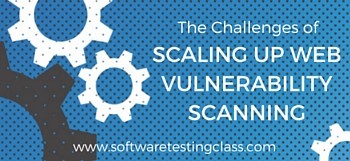In today’s class, we are talking about one of the interesting security testing topics “The Challenges of Scaling Up Web Vulnerability Scanning“.
*************
For SMBs (Small and Mid-size Businesses) and Large Enterprises alike, one of the most challenging aspects of managing IT involves deciding how to effectively scale up web application security. Many businesses are inadvertently finding themselves in the software and application business as they attempt to meet the needs of their customers. As a result, they’re faced with having to manage an increasingly large number of public-facing websites, web applications, and even internal web portals.
With total numbers ranging from just a few to hundreds and even thousands of web applications and web services, scaling up web application security can quickly become a challenge. Effective scaling isn’t just about doing more, it’s about doing more faster and with greater efficiency while maintaining a high degree of accuracy.
Speed, Agility and The Detriment to Web Application Security
Because of increasingly competitive environments, businesses are being forced to become more agile. While it is common for businesses to focus on ease-of-implementation, speed, and convenience, this is often done at the expense of security.
The implementation of new programming languages or frameworks without establishing a clear set of best practices, especially when it comes to web application security, often results in the creation of vulnerabilities and an ever-increasing attack vector.
The ideal solution is for developers to place a greater initial emphasis on security. However, until that happens, another way to re-mediate the problem is by making sure you’re able to scale up your web application security without putting a strain on resources. Easier said than done.
The Challenge of Scaling Web Application Security
Scaling web application security can be a challenge for any organization. Not only are application development teams focused on moving web applications to a production environment as quickly as possible, but security resources are also often limited with both teams and budgets being constrained.
Assuming an organization has implemented a development framework that results in consistent best-practices, the next step is to determine the most efficient method of scanning, identifying, and patching all vulnerabilities in the web applications.
Traditionally, with just a few web applications to scan, desktop scanners presented a simple solution. However, in the past three to four years, it has become obvious that with the number of web applications increasing dramatically, a more efficient method of web vulnerability scanning was needed.
Cloud-based scanning services resolve many of the issues with scalability and also make the process of managing and eliminating vulnerabilities more efficient.
How Cloud-Based Web Application Security Scanners Can Help You Scale
The most challenging part of scaling your web application security involves the proper allocation of human expertise and automation. Automated scanners alone are incapable of identifying all vulnerabilities. But they are also very efficient when it comes to identifying many of the common vulnerabilities such as SQL Injection and cross-site scripting (XSS). Typically, searching for and finding these types of vulnerabilities can be very time consuming when performed manually.
At the same time, human penetration testers are also incapable of effectively identifying and testing all vulnerabilities. Their strengths lie in identifying vulnerabilities that require intelligence and logic.
The ideal solution and one which is scalable combines both manual and automated efforts.
There are several features that you should look for in an automated vulnerability scanner — all of which will contribute directly towards increased scalability. These can include:
- The capability to launch one or 500+ websites or web application security scans in mere minutes. Once your scanner is configured, initiating multiple scans should require very little effort.
- Web Application Security Scanners should produce false-positive free results. This feature alone can significantly reduce the need for human intervention. A service like Netsparker Cloud tests each vulnerability and provides confirmation so precious labor hours are not wasted.
- The ability to provide enterprise-level collaboration. Allowing multiple users can streamline the entire process. This includes the ability to assign specific remediation tasks to specific team members. Once vulnerabilities are marked as resolved, a service like Netsparker Cloud will automatically retest the vulnerability and either close the ticket or reassign it for further investigation.
- Developers are often rushed to bring a web application into production. Using an automated vulnerability scanner that can be integrated into the development environment often results in a more secure application on launch. It also allows you to track the ongoing quality of work and the incidence of vulnerabilities. Tracking recurring vulnerabilities and their source can help to improve your systems and processes.
Scaling Web Application Security is About Finding Balance
Most SMBs and Large Enterprises are faced with the challenge of finding a cost-effective and efficient way of scaling their web application vulnerability testing.
Ultimately, the most effective way to scale your web application security involves two steps:
First, if you scan 100 websites or applications and expose an equally high number of different vulnerabilities, it’s probably cost-effective to reassess your development process. The implementation of frameworks and best practices can help to make all of your processes more efficient and more scalable. Eliminate as many recurring vulnerabilities as possible by making sure that the development process is consistent and has appropriate checks and balances.
Second, find a way to effectively balance human penetration testing with automated web vulnerability scanning. Human penetration testing is unscalable beyond just a few web applications. However, when combined with an automated online web vulnerability scanner, you can test hundreds or thousands of websites and web applications.
